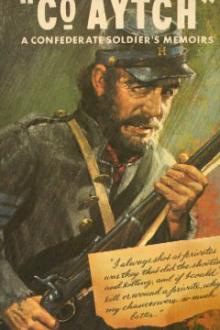The History Of Education by Ellwood P. Cubberley (little red riding hood read aloud .txt) 📕

- Author: Ellwood P. Cubberley
- Performer: -
Book online «The History Of Education by Ellwood P. Cubberley (little red riding hood read aloud .txt) 📕». Author Ellwood P. Cubberley
Though dead politically, there now occurred the unusual spectacle of “captive Greece taking captive her rude conqueror,” and spreading Greek art, literature, philosophy, science, and Greek ideas throughout the Mediterranean world. It was the Greek higher learning that now became predominant and exerted such great influence on the future of our world civilization. It remains now to trace briefly the development and spread of this higher learning, and to point out how thoroughly it modified the thinking of the future.
NEW SCHOOLS; SOCRATES. In the beginning each Sophist teacher was a free lance, and taught what he would and in the manner he thought best. Many of them made extraordinary efforts to attract students and win popular approval and fees. Plato represents the Sophist Protagoras as saying, with reference to a youth ambitious for success in political life, “If he comes to me he will learn that which he comes to learn.” At first the instruction was largely individual, but later classes were organized.
Isocrates, who lived from 436 to 338 B.C., organized the instruction for the first time into a well-graded sequence of studies, with definite aims and work (R. 8). He shifted the emphasis in instruction from training for success in argumentation, to training to think clearly and to express ideas properly. His pupils were unusually successful, and his school did much to add to the fame of Athens as an intellectual center. From his work sprang a large number of so called Rhetorical Schools, much like our better private schools and academies, offering to those Ephebes who could afford to attend a very good preparation for participation in the public life of the period.
In contrast with the Sophists, a series of schools of philosophy also arose in Athens. These in a way were the outgrowth of the work of Socrates. Accepting the Sophists’ dictum that “man is the measure of all things,” he tried to turn youths from the baser individualism of the Sophists of his day to the larger general truths which measure the life of a true man. In particular he tried to show that the greatest of all arts—
the art of living a good life—called for correct individual thinking and a knowledge of the right. “Know thyself” was his great guiding principle.
His emphasis was on the problems of everyday morality. Frankly accepting the change from the old education as a change that could not be avoided, he sought to formulate a new basis for education in personal morality and virtue, and as a substitute for the old training for service to the State.
He taught by conversation, engaging men in argument as he met them in the street, and showing to them their ignorance (R. 9). Even in Athens, where free speech was enjoyed more than anywhere else in the world at that time, such a shrewd questioner would naturally make enemies, and in 399 B.C. at the age of seventy-one, he was condemned to death by the Athenian populace on the charge of impiety and corrupting the youth of Athens.
[Illustration: FIG. 12 SOCRATES (469-399 B.C.) (After a marble bust in the Vatican Gallery, at Rome)]
Socrates’ greatest disciple was a citizen of wealth by the name of Plato, who had abandoned a political career for the charms of philosophy, and to him we owe our chief information as to the work and aims of Socrates. In 386 B.C. he founded the Academy, where he passed almost forty years in lecturing and writing. His school, which formed a model for others, consisted of a union of teachers and students who possessed in common a chapel, library, lecture-rooms, and living-rooms. Philosophy, mathematics, and science were taught, and women as well as men were admitted.
Other schools of importance in Athens were the Lyceum, founded in 335 B.C.
by a foreign-born pupil of Plato’s by the name of Aristotle, who did a remarkable work in organizing the known knowledge of his time; [7] the school of the Stoics, founded by Zeno in 308 B.C.; and the school of the Epicureans, founded by Epicurus in 306 B.C. Each of these schools offered a philosophical solution of the problem of life, and Plato and Aristotle wrote treatises on education as well. Each school evolved into a form of religious brotherhood which perpetuated the organization after the death of the master. In time these became largely schools for expounding the philosophy of the founder.
[Illustration: FIG. 13. EVOLUTION OF THE GREEK UNIVERSITY]
THE UNIVERSITY OF ATHENS. Coincident with the founding of these schools and the political events we have previously recorded, certain further changes in Athenian education were taking place. The character of the changes in the education before the age of sixteen we have described. As a result in part of the development of the schools of the Sophists, which were in themselves only attempts to meet fundamental changes in Athenian life, the education of youths after sixteen tended to become literary, rather than physical and military. The Ephebic period of service (from eighteen to twenty) was at first reduced from two years to one, and after the Macedonian conquest, in 338 B.C., when there was no longer an Athenian State to serve or protect, the entire period of training was made optional. The Ephebic corps was now opened to foreigners, and in time became merely a fashionable semi-military group. Instead of the military training, attendance at the lectures of the philosophical schools was now required, and attendance at the rhetorical schools was optional. Later the philosophical schools were granted public support by the Athenian Assembly, professorships were created over which the Assembly exercised supervision, the rhetorical and philosophical schools were gradually merged, the study years were extended from two to six, or seven, a form of university life as regards both students and professors was developed, and what has since been termed “The University of Athens” was evolved. Figure 13 shows how this evolution took place.
As Athens lost in political power her citizens turned their attention to making their city a center of world learning. This may be said to have been accomplished by 200 B.C. Though Greece had long since become a Macedonian province, and was soon to pass under the control of Rome, the so-called University of Athens was widely known and much frequented for the next three hundred years, and continued in existence until finally closed, as a center of pagan thought, by the edict of the Roman-Christian Emperor, Justinian, in 529 A.D. Though reduced to the rank of a Roman provincial town, Athens long continued to be a city of letters and a center of philosophic and scientific instruction.
SPREAD AND INFLUENCE OF GREEK HIGHER EDUCATION. Alexander the Great rendered a very important service in uniting the western Orient and the eastern Mediterranean into a common world empire, and in establishing therein a common language, literature, philosophy, a common interest, and a common body of scientific knowledge and law. It was his hope to create a new empire, in which the distinction between European and Asiatic should pass away. No less than seventy cities were established with a view to holding his empire together. These served to spread Hellenic culture.
Greek schools, Greek theaters, Greek baths, and Greek institutions of every type were to be found in practically all of them, and the Greek tongue was heard in them all. With Alexander the Great the history of Greek life, culture, and learning merges into that of the history of the ancient world. Everywhere throughout the new empire Greek philosophers and scientists, architects and artists, merchants and colonists, followed behind the Macedonian armies, spreading Greek civilization and becoming the teachers of an enlarged world. [8] “Greek cities stretched from the Nile to the Indus, and dotted the shores of the Black and the Caspian seas. The Greek language, once the tongue of a petty people, grew to be a universal language of culture, spoken even by barbarian lips, and the art, the science, the literature, the principles of politics and philosophy, developed in isolation by the Greek mind, henceforth became the heritage of many nations.” [9]
Greek universities were established at Pergamum and Tarsus in Asia Minor; at Rhodes on the island of that name in the Aegean; and at the newly founded city of Alexandria in Egypt. Antioch, in Syria, became another important center of Greek influence and learning. A large library was developed at Pergamum, and it was here that writing on prepared skins of animals [10] was begun, from which the term “parchment” (originally “per-gament”) comes. It was also at Pergamum that Galen (born c. 130 A.D.) organized what was then known of medical science, and his work remained the standard treatise for more than a thousand years. Rhodes became a famous center for instruction in oratory. During Roman days many eminent men, among whom were Cassius, Caesar, and Cicero, studied oratory here.
[Illustration: FIG. 14 THE GREEK UNIVERSITY WORLD]
MINGLING OF ORIENT AND OCCIDENT AT ALEXANDRIA. The most famous of all these Greek institutions, however, was the University of Alexandria, which gradually sapped Athens as a center of learning and became the intellectual capital of the world. The greatest library of manuscripts the world had ever known was collected together here. [11] It is said to have numbered over 700,000 volumes. These included Greek, Jewish, Egyptian, and Oriental works. In connection with the library was the museum, where men of letters and investigators were supported at royal expense. These two constituted an institution so like a university that it has been given that name. Alexandria became not only a great center of learning, but, still more important, the chief mingling place for Greek, Jew, Egyptian, Roman, and Oriental, and here Greek philosophy, Hebrew and Christian religion, and Oriental faith and philosophy met and mixed. It was this mingled civilization and culture, all tinged through and through with the Greek, with which the Romans came in contact as they pushed their conquering armies into the eastern Mediterranean (R. 10).
[Illustration: FIG. 15. THE KNOWN WORLD ABOUT 150 A.D.
A map by Ptolemy, geographer and astronomer at Alexandria. Compare this with the map on page 4, and note the progress in geographical discovery which had been made during the intervening centuries.]
CHARACTER OF ALEXANDRIAN LEARNING. The great advances in knowledge made at Alexandria were in mathematics, geography, and science. The method of scientific investigation worked out by Aristotle at Athens was introduced and used. Instead of speculating as to phenomena and causes, as had been the earlier Greek practice, observation and experiment now became the rule. Euclid (c. 323-283 B.C.) opened a school at Alexandria as early as 300 B.C., and there worked out the geometry which is still used in our schools. Archimedes (287-212 B.C.), who studied under Euclid, made many important discoveries and advances in mechanics and physics. Eratosthenes (226-196 B.C.), librarian at Alexandria, is famous as a geographer [12]
and astronomer, and made some studies in geology as well. Ptolemy (b.?; d.
168 A.D.) here completed his Mechanism of the Heavens (_Syntaxis_) in 138
A.D., and this became the standard astronomy in Europe for nearly fifteen hundred years, while his geography was used in the schools until well





Comments (0)